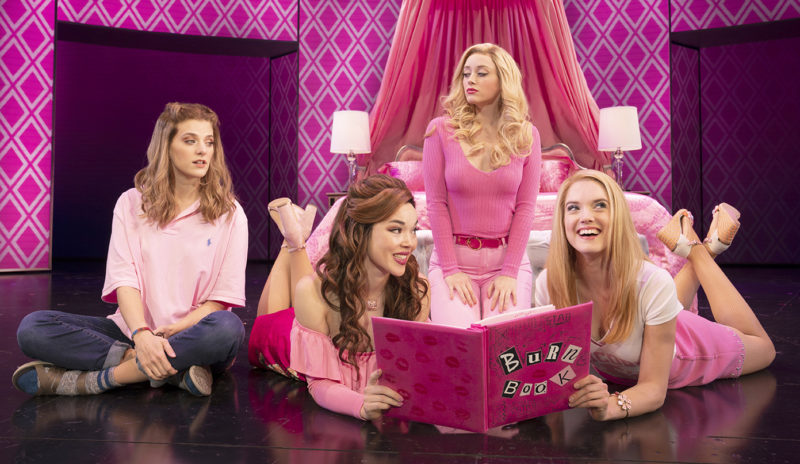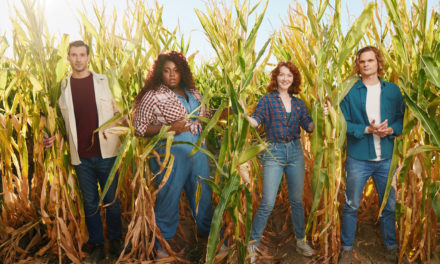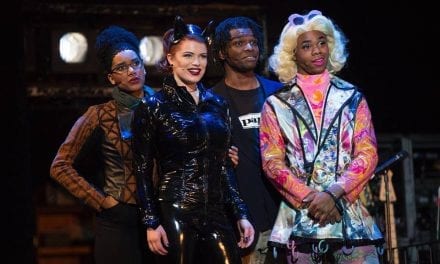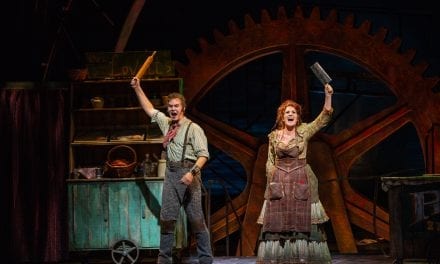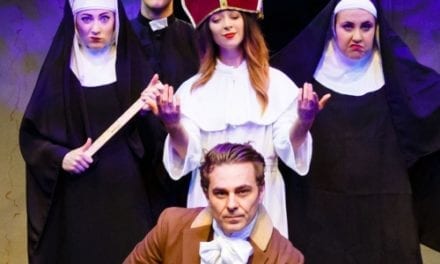SALT LAKE CITY — The Broadway tour of Mean Girls was a musical I went into with expectations of how I would react. I had seen the movie numerous times, I knew a couple of the songs from the musical, and I had friends who had seen it on Broadway. Unexpectedly, I loved seeing this show. Is it a perfect script? No. Is it the most impressive musical I’ll ever see? Absolutely not. But Mean Girls was extremely entertaining, the cast was unbelievable, and I would love to go see it again if I could. Mean Girls works really well as a tour show; it is not a show any local theater could do with the same talent or tech, and it is not going to shine brighter than the other Broadway shows currently in New York. Touring is the perfect middle ground for this show.

Show plays in Utah through December 5, 2021.
Still, the script is not great. Both the staged production and the original movie were written by Tina Fey, and the score in the stage version has music by her husband, Jeff Richmond, and lyrics by Nell Benjamin. Richmond’s music is good, but repetitive and simple. You could probably take the leading actresses in the show, switch all their parts, and the performers would still be able to sing the new songs perfectly well because all the female characters have the same music style. It is a fun and catchy score, but it lacks uniqueness.
Fey’s script itself is funny, just like the movie, but that is a problem. All the big jokes from the movie are emphasized and overblown to the point where the audience didn’t seem to enjoy them. The biggest laughs came at the jokes that were new to the stage version.
Also, the script does not portray how social media actually works. No one has ever seen someone they did not like in real life, and then sincerely said “Unsubscribe” out loud to their face. Mean Girls is like many movies in this regard, but it feels like a lot of the jokes are something middle-aged producers would enjoy because they get to make fun of the youth. Actual teens who come to see the show will most likely feel disconnected from the show because of it. The parts of the musical that did feel genuinely “teen” were all in elements of direction and design.
 Because this is a musical based on a widely known and beloved movie, there are many parts of the show that look a lot like said movie. Casey Nicholaw’s direction was faithful to the movie, but the play never felt like the goal was to create a reenactment of the movie. Nicholaw also served as a great choreographer for the musical. His dances were impressive but never over-complicated and did not attention away from the main characters. My favorite part was in the math class, with subtle movements and synchronized tapping of their pencils.
Because this is a musical based on a widely known and beloved movie, there are many parts of the show that look a lot like said movie. Casey Nicholaw’s direction was faithful to the movie, but the play never felt like the goal was to create a reenactment of the movie. Nicholaw also served as a great choreographer for the musical. His dances were impressive but never over-complicated and did not attention away from the main characters. My favorite part was in the math class, with subtle movements and synchronized tapping of their pencils.
 The combined work of scenic designer Scott Pask and video designers Finn Ross and Adam Young are really what makes this show. The physical set is dynamic and interesting, and the small pieces, such as classroom desks or a bed, blend in well with everything. But those projections! The timing, and the coloring, and the artistry, and the 3-D-ness, and the variety— all of it is so breathtaking. I especially loved the copy machine bits and the graffiti in the bathroom (although it was interesting that the students graffitied the exact same things on the outside of the school as they did on the bathroom walls).
The combined work of scenic designer Scott Pask and video designers Finn Ross and Adam Young are really what makes this show. The physical set is dynamic and interesting, and the small pieces, such as classroom desks or a bed, blend in well with everything. But those projections! The timing, and the coloring, and the artistry, and the 3-D-ness, and the variety— all of it is so breathtaking. I especially loved the copy machine bits and the graffiti in the bathroom (although it was interesting that the students graffitied the exact same things on the outside of the school as they did on the bathroom walls).
 Kenneth Posner’s lighting designs worked well with the scenic and lighting designs. All the lights were sharp and angular, and the cued lights looked very cool and nice. However, the spotlight operators seemed to be having trouble knowing where to shine and when to be on. I saw the show the first night it opened in Salt Lake City, so this may be a consequence of performing in a new and unfamiliar space, but the spotlights did become quite distracting during the second act.
Kenneth Posner’s lighting designs worked well with the scenic and lighting designs. All the lights were sharp and angular, and the cued lights looked very cool and nice. However, the spotlight operators seemed to be having trouble knowing where to shine and when to be on. I saw the show the first night it opened in Salt Lake City, so this may be a consequence of performing in a new and unfamiliar space, but the spotlights did become quite distracting during the second act.
Speaking of tech problems, while I enjoyed Brian Ronan’s sound design, this aspect of the show suffered in Salt Lake City. The Eccles Theater seems to use its stage speakers far more than the rest of the sound system, and the only options are either “way too loud” or “way too quiet.” Mean Girls chose way too loud. The sound design itself was superb, but mixed poorly. Everything was at the same level, so it was difficult to tell what words were supposed to be, especially if multiple people were singing at the same time. The lyrics seemed to be good, but I do not know for sure. The only times the cast seemed to have consistent clear diction were on the Big Jokes from the movie.
One element of the show that felt genuinely connected to current teen culture was the costume, hair, and makeup designs, by Gregg Barnes, Josh Marquette, and Milagros Medina-Cerdeira, respectively. All the actors looked like they were wearing real high schoolers’ clothes, with hair and makeup to match. My favorite costumes included a flower-patterned suit jacket during the Spring Fling and a woman dressed as either sexy Yoda or sexy Shrek in the “Sexy” song. (I couldn’t quite tell which one it was, but I liked it either way.) My one large gripe is Regina’s fat suit towards the end of the first act. The character gained an improbable amount of weight, all in only one area of the body. The fat suit does not show practical weight gain, and the Santa dress joke would work just as well without the fat suit.
As for the actors: Danielle Wade was effortlessly talented as Cady Heron, and she is absolutely phenomenal in the role in both singing and acting. Mary Kate Morrissey as Janis had an impressive voice, and while she had the perfect angst down right, the character never gelled together. In every line he spoke or sang, Eric Huffman as blew me away. Nadia Hassan as Regina George was also extremely talented. She can really belt, and one of my favorite moments in the show was seeing twelve-year-old Regina, in which Hassan did a great job of showing the sudden age change.
Mean Girls is a show in which the ensemble plays a huge role, and there was not a single weak link. The actors playing the Plastics were all some of the funniest performers I’ve seen in a while. They each knew exactly what their jokes were supposed to be and delivered each line perfectly, although Megan Masako Haley’s Gretchen Wieners was probably the most impressive comedically. Understudy Becca Peterson was superb in the role of Karen Smith and gave a flawless performance. Each actor believably acted like teenagers, with insecurities, flaws, and a level of adolescent naivety. The three actors playing the adult characters—April Josephine, Will Branner, and Lawrence E. Street—were fantastic, especially Josephine as Mrs. George. I loved the relationship between Regina and her mother in this version.
Finally, it is realistic for teenage girls to make fun of each other by accusing one another of being a lesbian. But the way the show handles that could be better. When insulting Janis in the Burn Book, the Plastics use the same wording, specifically a slur, that they do in the movie. Other characters continue to use said slur without batting an eye. It is very clear that none of the characters in the world of the play understand it to be a slur, which may lead audience members to not understand the levity of the situation. The characters seem to know little more than that being called lesbian is bad. The script could have had at least one character make it clear that being gay is not a bad thing. The purpose Janis and Damian serve in the show is to be made fun of for being gay stereotypes. It makes sense that the Plastics would make fun of them for this, but it is the show itself that makes fun of these stereotypes, and consequentially gay people. In the world of the play, the characters hate lesbians, and it is quirky and weird to have a gay best friend.
Despite some drawbacks, I loved seeing Mean Girls. It is an energetic, funny, and compelling show that was easy to sit through. It has its flaws, but I would absolutely pay to go see it again because Mean Girls is a triumph of acting and design.

These reviews are made possible by a grant from the Salt Lake County Zoo, Arts, and Parks program.

